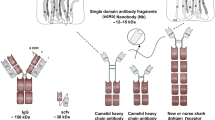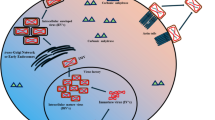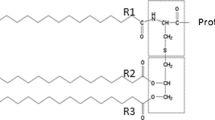Abstract
The adjuvanticity of Hansenula polymorpha, Saccharomyces cerevsiae and Yarrowia lipolytica were compared for oral and nasal immunization with virus capsid antigens. Mice were immunized orally with human papillomavirus type 16 L1 virus-like particles (HPV16 L1 VLPs), or intra-nasally with formalin-inactivated influenza A virus (FIV), in combination with one or other yeast. Mice receiving HPV16 L1 VLPs combined with H. polymorpha had a significantly higher titer for serum anti-HPV16 L1 IgG and neutralizing activity than those receiving HPV16 L1 VLPs combined with either of the other two yeasts. Also, mice receiving FIV combined with H. polymorpha had not only a markedly higher anti-influenza A virus IgG titer but also a higher survival rate after a potentially lethal influenza A virus challenge. We suggest that H. polymorpha thus will be useful for enhancing immune responses in mucosal immunizations.




Similar content being viewed by others
References
Celik E, Calik P (2012) Production of recombinant proteins by yeast cells. Biotechnol Adv 30:1108–1118
DeVane L (2004) Principles of pharmacokinetics and pharmacodynamics. In: Schartzberg AF, Nemeroff CB (eds) The American Psychiatric Publishing Text-book of Psychopharmacology, 3rd edn. American Psychiatric Pub, Washington, DC, pp 181–200
Food and Drug Administration US (2001) Partial list of microorganisms and microbial-derived ingredients that are used in foods. http://wwwfdagov/Food/FoodIngredientsPackaging/ucm078956htm
Frech SA, Dupont HL, Bourgeois AL, McKenzie R, Belkind-Gerson J, Figueroa JF, Okhuysen PC, Guerrero NH, Martinez-Sandoval FG, Melendez-Romero JH, Jiang ZD, Asturias EJ, Halpern J, Torres OR, Hoffman AS, Villar CP, Kassem RN, Flyer DC, Andersen BH, Kazempour K, Breisch SA, Glenn GM (2008) Use of a patch containing heat-labile toxin from Escherichia coli against travellers’ diarrhoea: a phase II, randomised, double-blind, placebo-controlled field trial. Lancet 371:2019–2025
Kim HJ, Kim SY, Lim SJ, Kim JY, Lee SJ (2010) One-step chromatographic purification of human papillomavirus type 16 L1 protein from Saccharomyces cerevisiae. Protein Expr Purif 70:68–74
Kim HJ, Lim SJ, Kwag HL (2012) The choice of resin-bound ligand affects the structure and immunogenicity of column-purified human papillomavirus type 16 virus-like particles. PLoS ONE 7:e35893
Kushnir N, Streatfield SJ, Yusibov V (2012) Virus-like particles as a highly efficient vaccine platform: diversity of targets and production systems and advances in clinical development. Vaccine 31:58–83
Matsuura Y, Tohya Y, Mochizuki M, Takase K, Sugimura T (2001) Identification of conformational neutralizing epitopes on the capsid protein of canine calicivirus. J Gen Virol 82:1695–1702
McKenzie R, Bourgeois AL, Frech SA, Flyer DC, Bloom A, Kazempour K, Glenn GM (2007) Transcutaneous immunization with the heat-labile toxin (LT) of enterotoxigenic Escherichia coli (ETEC): protective efficacy in a double-blind, placebo-controlled challenge study. Vaccine 25:3684–3691
Mestecky J, Russell MW, Elson CO (2007) Perspectives on mucosal vaccines: is mucosal tolerance a barrier? J Immunol 179:5633–5638
Murtaugh MP, Foss DL (2002) Inflammatory cytokines and antigen presenting cell activation. Vet Immunol Immunopathol 87:109–121
Oyewumi MO, Kumar A, Cui Z (2010) Nano-microparticles as immune adjuvants: correlating particle sizes and the resultant immune responses. Expert Rev Vaccines 9:1095–1107
Pavot V, Rochereau N, Genin C, Verrier B, Paul S (2012) New insights in mucosal vaccine development. Vaccine 30:142–154
Reed LJ, Muench H (1938) A simple method of estimating fifty percent endpoint. Am J Hyg 27:493–497
Renukuntla J, Vadlapudi AD, Patel A, Boddu SH, Mitra AK (2013) Approaches for enhancing oral bioavailability of peptides and proteins. Int J Pharm 447:75–93
Shi L, Sanyal G, Ni A, Luo Z, Doshna S, Wang B, Graham TL, Wang N, Volkin DB (2005) Stabilization of human papillomavirus virus-like particles by non-ionic surfactants. J Pharm Sci 94:1538–1551
Slutter B, Hagenaars N, Jiskoot W (2008) Rational design of nasal vaccines. J Drug Target 16:1–17
Thomas DS (1988) Electropositively charged filters for the recovery of yeasts and bacteria from beverages. J Appl Bacteriol 65:35–41
Thones N, Herreiner A, Schadlich L, Piuko K, Muller M (2008) A direct comparison of human papillomavirus type 16 L1 particles reveals a lower immunogenicity of capsomeres than virus like particles with respect to the induced antibody response. J Virol 82:5472–5485
Tuthill TJ, Harlos K, Walter TS, Knowles NJ, Groppelli E, Rowlands DJ, Stuart DI, Fry EE (2009) Equine rhinitis A virus and its low pH empty particle: clues towards an aphthovirus entry mechanism? PLoS Pathog 5:e1000620
Van de Graaff KM (1986) Anatomy and physiology of the gastrointestinal tract. Pediatr Infect Dis 5:S11–S16
van Zutphen T, Baerends RJ, Susanna KA, de Jong A, Kuipers OP, Veenhuis M, van der Klei IJ (2010) Adaptation of Hansenula polymorpha to methanol: a transcriptome analysis. BMC Genomics 11:1
Xiang SD, Scholzen A, Minigo G, David C, Apostolopoulos V, Mottram PL, Plebanski M (2006) Pathogen recognition and development of particulate vaccines: does size matter? Methods 40:1–9
Xu ML, Kim HJ, Choi YR, Kim HJ (2012) Intake of Korean red ginseng extract and saponin enhances the protection conferred by vaccination with inactivated influenza A virus. J Ginseng Res 36:396–402
Zhang H, Huang Y, Fayad R, Spear GT, Qiao L (2004) Induction of mucosal and systemic neutralizing antibodies against human immunodeficiency virus type 1 (HIV-1) by oral immunization with bovine Papillomavirus-HIV-1 gp41 chimeric virus-like particles. J Virol 78:8342–8348
Acknowledgments
This study was supported by grant from the Korean Ministry of Rural Development Administration (2013 Next-Generation Bio-Green 21 Programme Nos. ADFC2013-PJ009586).
Author information
Authors and Affiliations
Corresponding author
Electronic supplementary material
Below is the link to the electronic supplementary material.
Rights and permissions
About this article
Cite this article
Lee, J.Y., Xu, M.L., Kim, H.J. et al. A comparative study of the adjuvanticity of Hansenula polymorpha, Saccharomyces cerevsiae and Yarrowia lipolytica in oral and nasal immunization with virus capsid antigens. Biotechnol Lett 35, 1881–1888 (2013). https://doi.org/10.1007/s10529-013-1273-8
Received:
Accepted:
Published:
Issue Date:
DOI: https://doi.org/10.1007/s10529-013-1273-8




